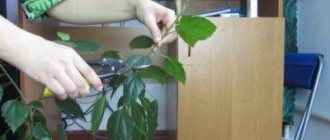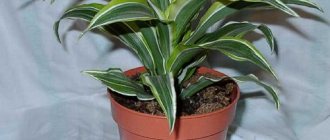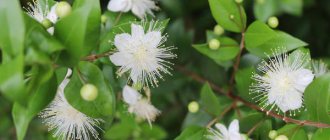All types of dracaenas are ideal plants for home keeping . They are able to grow both on bright south-eastern window sills and in the back of the room under artificial light. They also have no special requirements for soil composition and room humidity.
Most species of these palms grow very tall in nature. As they grow, the lower leaves age and fall off, the stem gradually becomes bare and the plant loses its decorative appearance. Therefore, pruning of dracaena is necessary to obtain side shoots.
What types of dracaena need to be pruned?
Among the variety of dracaenas, there are varieties that require regular pruning. These are the varieties Reflexa, Surculose, and Fragrant.
Dracaena Reflexa
In nature, it is a huge tree up to 10 m tall. In home floriculture, it is grown as a bush up to 1 m in height. The plant has brightly colored, pointed leaves, up to 20 cm, and thick, powerful stems. Foliage color ranges from dark to light shades of green, with beige or yellow stripes.
Dracaena Surculosa (Surculosa)
New shoots grow out of the ground. In room conditions it reaches a height of 1.5 meters. This species grows well in width, and the number of shoots in the pot increases quickly. The leaves are oval, with a pointed edge.
Several subspecies of this dracaena have different foliage colors. Juicy bright green leaves are covered with yellow, white, cream or light green spots of different diameters.
Dracaena fragrant (Fragrans)
In nature it reaches a height of six meters. At home it grows up to 1.5–2 meters . Bright, glossy leaves 60 cm long tightly cover the erect stem. The color of the leaves is plain, dark green or with light stripes.
Plant varieties
Dracaena is an evergreen shrub belonging to the Agave genus. Each variety has its own characteristics for care and pruning. The most popular types:
| Photo | Description |
| The largest type for apartment maintenance. The plant has drooping, curved leaves of variegated color. Grows in height up to 5 meters. Therefore, it is better to grow in rooms with high ceilings. Caring for a plant is complex and requires certain skills. |
| The bush is branched, small in size. As the plant grows, it forms several stems that emerge directly from the root system. The leaf blade is elongated and curved, painted a bright olive color with yellow stripes. This variety does not require formative pruning. |
| A medium-sized plant with spotted dark green leaves. This species requires regular pruning to achieve a beautiful appearance. New shoots are periodically formed, and without pruning the crown of the tree loses its attractive appearance |
| A large tree with a strong woody trunk. Dark olive, wide leaves have pronounced lemon or snow-white stripes |
| An attractive, but rather difficult to care for look that is loved by many gardeners. Wide round leaves are transversely colored with white-olive stripes |
Trimming time
When can you prune dracaena?
Favorable time for pruning is April and May . This is a period of active growth during which sap flow begins. During these months, phytohormones are actively produced: cytokinins and auxins, which contribute to the rapid growth of lateral shoots. The wound after pruning in the spring will quickly heal.
Is it possible to prune dracaena in winter and summer?
In the summer and winter months it is not recommended to form a crown. These are periods of rest when all processes in the plant slow down. New buds may not appear for a long time after pruning and the wound on the cut will take a long time to heal. Pruning during this period is a lot of stress for the flower .
ATTENTION! Winter pruning is allowed in emergency cases when the stem of the plant is broken.
How to determine the need for pruning?
Before pruning begins, you need to determine whether it is really necessary. Remember that experts strongly recommend performing the procedure as rarely as possible. But still, occasionally pruning is really necessary, but you only need to cut off a minimal amount of the plant.
So, pruning is necessary for the following reasons:
- For safety if the plant grows in close proximity to the house.
- For aesthetic reasons (dying or dead leaves are removed).
- To reduce the size of a plant if it has grown too large.
- For easy collection of seeds, fruits or flowers.
Still, it is advisable to prune only when truly necessary, and not for aesthetic reasons. The latter can significantly harm the plant.
To determine problems with a palm tree, it is worth examining its leaves and branches. A brown, yellow or white tint will indicate that they are dying or already dead, and they will droop downwards. © https://ydoo.info/qa/kak-obrezat-palmu.html By the way, yellow leaves indicate a lack of potassium. In this case, pruning is unacceptable, as the plant will die. Apply a potassium fertilizer to the soil and avoid pruning for at least one year.
Pay attention to the presence or absence of broken branches. If they are present (including broken ones), remove them immediately before the tree begins to die. Keep in mind that the presence of flowers or fruit also takes energy from the plant and slows down its growth, so it may be wise to remove them.
If there are no damaged or dying leaves, fruits or flowers, or other problems, there is no need to prune the tree. It will only hurt him.
Methods and rules for crown formation
To form the crown of dracaenas, there are two pruning methods.
Sanitary and preventive pruning
With this method, diseased, damaged leaves and shoots are removed.
Most flower diseases appear due to improper care : overwatering, dry air, drafts.
This is immediately reflected in the leaves, which begin to turn yellow, dry out and fall off.
The stem quickly becomes bare and the plant becomes unattractive. Therefore, ten days after treating the flower with fungicides, it is possible to prune.
The purpose of pruning is to prevent further spread of the disease and remove damaged leaves and shoots.
Decorative pruning
Aimed at forming dracaena of a beautiful shape, with leafy shoots.
How to understand that you need to pinch the top to get side shoots:
- the plant has grown almost to the ceiling and has become too tall, making it difficult to care for;
- shoots become deformed and take on an ugly shape;
- the plant has only one trunk, which is bare and looks unattractive.
- the plant must be healthy , free from pests;
- Do not combine replanting and pruning the plant ; the interval between these procedures is up to two months.
How to prune dracaena correctly:
Items needed for pruning:
- sphagnum moss - has a loose structure, is able to absorb and retain moisture;
- garden varnish - will protect the wound from leakage of juice and from infection;
- sharp pruning shears or knife - to obtain an even cut.
What problems may arise
Dracaena is an unpretentious crop, but there are several rules, the observance of which will help keep the flower beautiful and healthy and will not lead to its premature death:
- moderate watering, the soil should be slightly moist. The flower easily tolerates drought;
- When replanting a flower, use only new (disposable) pots. The use of used containers increases the likelihood of contracting any infection;
- wean the flower from the greenhouse in time.
Important! Dracaena is a succulent plant. Excessive watering can lead to its death.
Dracaena is a universal decorative flower that will be appropriate in any room, creating a unique atmosphere. By giving the plant an original shape, you can further emphasize its tropical origin and enjoy its exotic appearance for many years.
Step-by-step instructions for crown formation
How to prune dracaena at home without harming the plant? Let's consider the main stages of how to form a crown:
- Determine the cutting height. Make a mark on the trunk where young shoots should appear.
- Make an even cut with a quick movement. Use sharp pruning shears or a knife. Do not break off the top.
- Juice will be released from the cut site, which must be removed with a piece of cotton wool. Then treat the cut area with melted garden varnish. Do not use it very hot, so as not to burn the plant.
- Remove leaves on the remaining shoot 15 cm below the cutting level.
- Spray the trunk with water. During pruning, the plant loses a lot of moisture necessary for normal development.
- Wrap the trunk where the leaves were removed with sphagnum moss and carefully secure it with thread. Regularly moisturize this area and prevent it from drying out.
- Moisten the soil by watering through a tray.
- Before the side shoots appear, place a transparent bag on the shortened part of the plant. It will create a greenhouse effect, increase humidity in the pruning area and promote the appearance of buds. Once every five days, remove the bag for ventilation to prevent the formation of a fungal infection.
- Move the pot with the plant from a sunny windowsill to a dark place with a high temperature.
You can also cover the cut area with polyethylene, as shown in this video, then you will not have to constantly moisten this area:
ADVICE! It is advisable to trim the stems at different heights. As the side shoots grow, tufts of greenery will form along the entire length of the plant. The bush will look voluminous and fluffy.
Basic rules for growing dracaena
Dracaena feels good both in shaded places and in well-lit ones, but keep in mind that a culture with variegated leaves retains its uniqueness in lighted rooms, while a flower with green leaves feels better in partial shade.
Dracaena does not grow very well with frequent and abundant watering, while it responds favorably to spraying the crown (especially in winter, when the air becomes dry due to heating).
The temperature regime of the room where the crop grows should have the following indicators: in winter from +15°C to +18°C, in summer from +20°C to +26°C.
Did you know? In the Middle Ages, the juice of the dracaena tree was widely used as medicine and wood varnish. In particular, the famous master Stradivari used it to create his legendary violins.
To rejuvenate the plant or propagate it, it is necessary to prune the crop in a timely manner.
Caring for dracaena after pruning
After pruning the dracaena, it is advisable to create comfortable conditions:
- A month after pruning, the dracaena should have new side shoots. During this period, remove the greenhouse from the flower and move the pot to a permanent place.
- Room humidity - 75%; air temperature - up to 25 °
- Lighting. Ensure a uniform supply of diffused sunlight.
- Periodically turn the pot with the plant so that the shoots do not reach towards the light and develop evenly.
- Make sure the soil is constantly moist, but do not allow it to overflow.
- Spray the crown once a day with settled or filtered water.
- A stream of water is a fine spray that will evenly moisten the entire surface of the sheet. Once a week add “Epin” or “Zircon” to stimulate the growth of new shoots.
IMPORTANT! Make sure that water does not get into the rosettes of leaves during sprinkling. This will protect the plant from trunk rot.
Dracaena tolerates pruning well and allows the formation of a fluffy crown. With the help of simple pruning, the aesthetic appearance is easily maintained and a beautiful plant shape is formed.
What to do with cut shoots?
When pruning dracaena, we are left with shoots. Which can be used when propagating dracaena. There are two ways to root shoots:
- the first is to simply put the shoots in a container of water and wait until they take root. With such rooting, we change the water in the container every day; dracaena shoots tend to fade in water. As soon as the shoots give roots, they can be planted in separate pots, using ordinary soil for indoor plants.
- the second is to cut the shoot into an equal number of pieces (no more than 5-10cm) and they take root in the soil. The soil will consist of a mixture of peat and sand. As soon as the cuttings take root, we transplant them into separate containers.
How to branch dracaena
There are times when a flower is moved from place to place in the house, the dracaena breaks. Don't think that the plant is dead. The situation can be corrected by pruning, with the help of which it will branch and restore a lush crown. The same procedure can be carried out when the plant’s leaves suddenly begin to dry out and fall off. If the flower has not one, but several trunks, cut them all off, leaving small stumps of the same height.
Advice. To obtain a new crown in several tiers, it is recommended to cut branches at different heights. Then the buds will appear accordingly.
If the dracaena stretches upward
If the dracaena has grown too much and its top touches the ceiling, it needs to be shortened at the top. This procedure is done in several stages. With the help of pruning, the plant is not only shortened, but also made more magnificent.
From tall dracaena you can also obtain materials for the purpose of reproduction. You can use not only the top, but also the long parts of the trunk. They are placed in water to form roots.
The top can be planted directly into the pot. To do this, the cut must be treated with a preparation to stimulate root formation. The planted cuttings must be covered with a plastic bag to create a greenhouse effect.
Lush crown of dracaena, formed in several tiers
Parts of the trunk are cut into small cuttings ten centimeters long. Shallow cuts are made on them and rooted. There are two rooting methods:
With the vertical rooting method, it is important not to confuse the lower part of the trunk with the upper. The cuttings must be covered with polyethylene to preserve the microclimate.
In this way, you can correct the stretched dracaena and at the same time grow new plants.
Forming a dracaena crown can be done by anyone. The plant becomes lush and beautiful. To do this, you just need to follow the step-by-step rules and recommendations for successfully pruning a flower.
Selecting tools and protective equipment
If pruning is truly necessary, you should decide on the appropriate tool. There are many suitable options, the best of which is selected based on the size of the branches and the tree as a whole.
So, you can use:
- A knife with a serrated edge. It is ideal for trimming branches whose diameter is less than 2.5 cm. It can also be used to remove flower stalks.
- Large pruning shears or scissors. Thanks to them, it is easy to remove large branches with a diameter of over 2.5 cm.
- Hand saw. It will allow you to easily get rid of thick and large branches.
- Chainsaw. It is the last possible option, thanks to which you can get rid of the thickest and largest branches.
If you are pruning a large palm tree in your garden, you may need equipment to reach the top of the plant. Depending on the height of the flower, you can use a stepladder or stool, a ladder or even a bucket truck.
Don't forget to take care of protection. In particular, it is worth using safety glasses and gardening gloves. Keep in mind that palm leaves have sharp thorns along the edges, so hand cuts are not uncommon. And if the chosen tool is a saw or pruning shears, then there is a high probability of particles of debris getting into your eyes.
If necessary, you can consult with experts. They will tell you how to prune correctly to achieve the best results.











